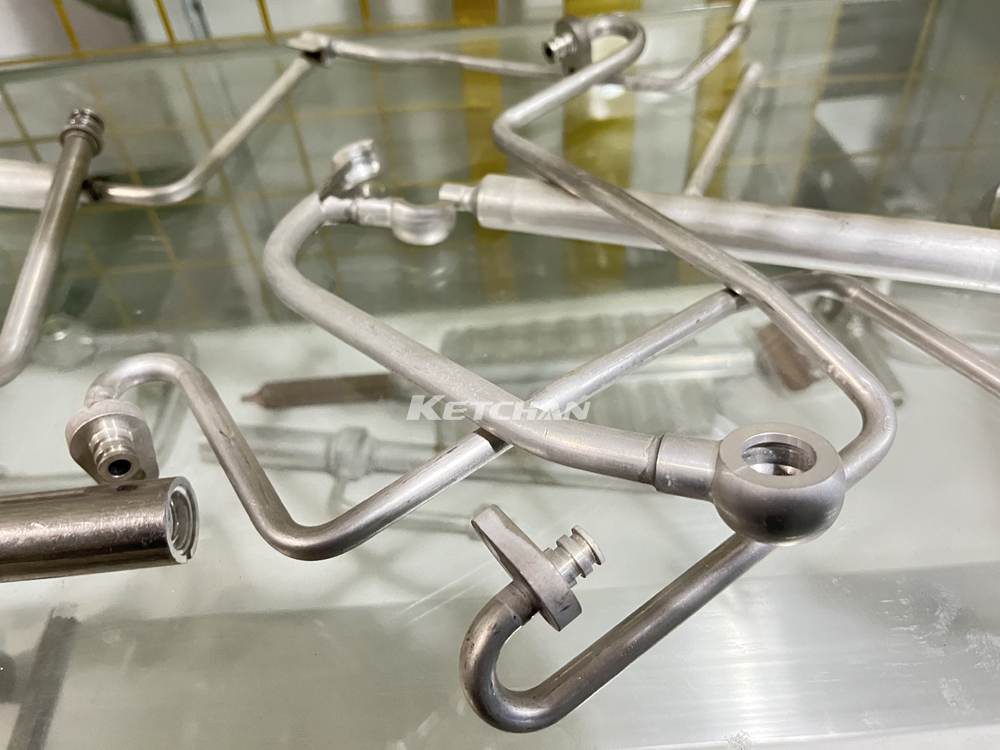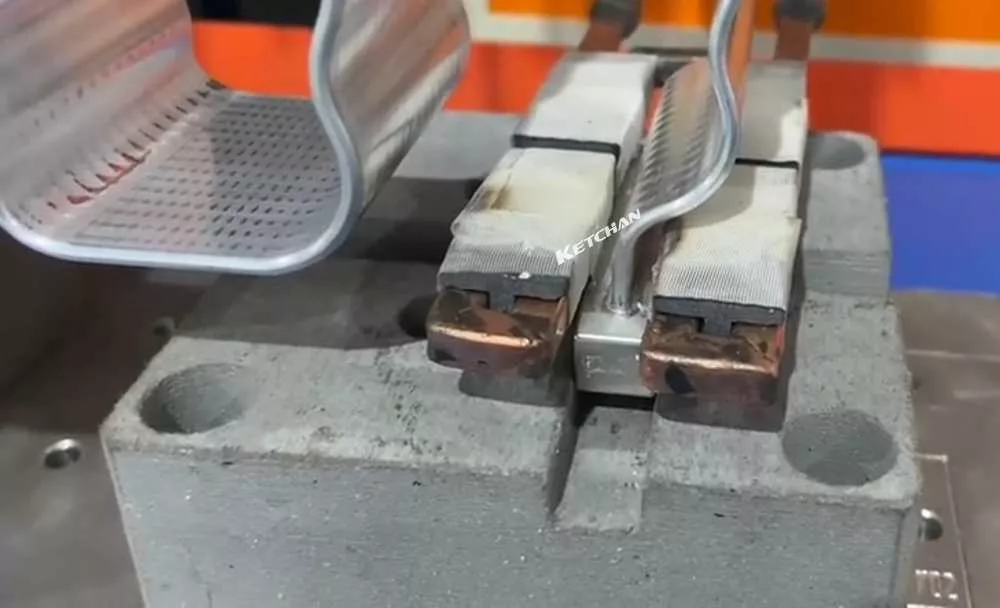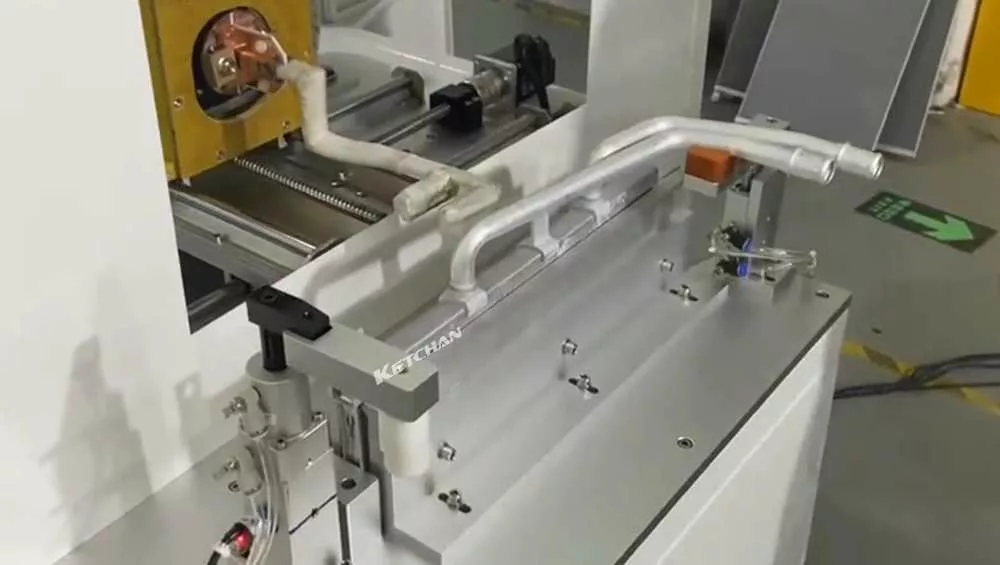
If you were given the best brazing equipment, could you make the best product? Raising this topic may cause strong dissatisfaction among engineers, but as long as you have not read this article, my answer to this question is no, so I still advise you to calm down and read this article carefully. Because I don’t think you can use the best brazing equipment to weld a product with a high qualification rate and beautiful appearance!
Difficulties in brazing aluminum parts
- It is easy to form an extremely dense oxide film on the surface. The nature of this oxide film is very stable. Covering the surface of the workpiece will prevent the solder from wetting on the surface of the workpiece, thus affecting the quality of brazing. The melting point of the oxide film on the surface of the aluminum alloy is very high, and at the brazing temperature of 270°C, the thickness of the oxide film increases sharply compared to room temperature, seriously hindering the wetting and bonding of the filler metal and the base metal. This is also the main reason why aluminum alloy is difficult to repair after being brazed once;
- When brazing aluminum alloys, on the surface of the base metal with oxides, the liquid solder often condenses into a spherical shape, does not wet the base metal, and does not fill the gaps.
It should be noted that the brazing performance of the material cannot be changed, but we can improve the welding quality by improving the brazing process.
Commonly used brazing methods for aluminum metal
When brazing aluminum metal, we mainly use the following brazing methods:
- Artificial flame brazing;
Artificial flame brazing has smoke, noise, open flames, and other factors that are detrimental to the operator’s personal safety and health. Because the on-site operation conditions of artificial flame brazing are very difficult, companies that use artificial flame brazing have difficulty recruiting flame welders. As the number of employees in this position continues to decrease, labor remuneration has also increased, and the cost of recruiting a flame welder has become more and more expensive. Come higher and higher. At the same time, open flames will be produced when using flame welding, which will undoubtedly bring a series of safety problems to production work. Judging from the current development status of the welding industry, the artificial flame welding method is becoming lonely, and only exists in some small companies or places with relatively backward productivity levels.
2. Automatic flame turntable;
The automatic flame turntable is undoubtedly an upgraded version of artificial flame welding. The flame turntable prevents operators from directly using flames for welding. The skill requirements for workers are also greatly reduced. Although the flame turntable does solve some problems, it still cannot avoid the problems of high temperature, open flame, pollution, and noise. At the same time, the flame turntable has stricter requirements on the gas path on site. It is indeed difficult for small and medium-sized enterprises to meet such high requirements on site. Moreover, the current purchase cost of the flame turntable is not low. In addition, it cannot avoid open flames. Therefore, it does not solve the root of the problem and still poses a major safety hazard.
3. High-frequency induction heating equipment;
High-frequency induction heating equipment is a kind of brazing equipment that uses clean energy. It is small in size and relatively light in weight. It is ready to use and is very suitable for flexible production. Especially for some standardized pipeline products, high-frequency induction heating equipment can directly realize automation or semi-automation, greatly improving production efficiency. Compared with the flame welding method, the energy consumption of high-frequency induction heating power supply is lower, which saves the company a lot of production costs. The most important thing is that the use of high-frequency welding avoids the appearance of open flames and greatly improves production safety.
4. Brazing tunnel furnace;
The brazing tunnel furnace has great advantages for welding some special-shaped workpieces, and its temperature control is relatively precise. It is also a widely used equipment in the welding industry. However, the brazing tunnel furnace mostly uses resistance wire heating, which has the problems of slow heating speed and relatively large power consumption. During production, the furnace needs to be turned on in advance for heating. This period of time undoubtedly wastes huge amounts of electricity and places a considerable burden on the company. There is an inevitable problem of power waste when welding products with multiple models and a small number of individual products. The brazing tunnel furnace obviously cannot meet the needs of flexible production. Moreover, the brazing tunnel furnace is expensive, which is a relatively large expense for small and medium-sized enterprises.
Aluminum Pipe Induction Brazing
Factors restricting the popularity of induction brazing
From the above description, we can actually clearly see that the use of high-frequency induction heating power sources has great potential in the future welding market. Induction heating technology has been developed for so many years and has become a very mature technology, but why is it not as widely used in actual applications as imagined? Especially when it comes to some metals that are difficult to weld, such as aluminum, everyone’s confidence in induction heating equipment has decreased. A lot has been learned. Let’s analyze the factors that restrict the popularity of induction brazing.
- The power supply technology is relatively backward and cannot achieve the expected results under harsh requirements;
Most induction heating power supplies on the market use Japanese technology from the last century. The main disadvantage of using analog control circuits is that the control method is relatively backward and cannot accurately control a certain heating current, resulting in temperature requirements during the welding process. It is difficult to automatically adjust when the heating current is relatively high or when the heating current needs to be changed. For a relatively “fragile” metal like aluminum, it is basically a disaster. With the advancement of science and technology, digital control methods have become the default standard in the industry. For the most basic and important application of heating, without advanced control methods, it is difficult to ensure the accuracy of the processing process, and of course it is impossible to talk about it. On product quality. Looking at the development of global induction heating technology, induction heating power supplies that used analog control circuits in Europe and Japan as early as the last century have all been eliminated. With the improvement of China’s manufacturing capacity and industrial level, induction heating equipment controlled by analog circuits in China has been eliminated by the wheel of history after all!
- Induction coil limitations
Due to the principle of induction heating, induction heating equipment must use an induction coil to enable the workpiece to heat itself. The closed induction coil is undoubtedly the most efficient way. It is precisely because the shape of the induction coil limits the use scenarios of certain products that it is difficult to achieve satisfactory results when heating and welding heterosexual parts and products that are difficult to clamp.
- Aluminum welding solder
Due to the physical properties of aluminum metal, the melting point of aluminum metal is very low. It is difficult for us to find a material that has a much lower melting point than aluminum metal and can also ensure good welding results to weld aluminum parts. Although I said it is difficult, it does not mean that it is impossible. Commonly used solders for aluminum metal welding include:
- Ordinary aluminum welding wires are mostly solder with the brand name 4047. The main component is aluminum, and it needs to be welded with additives;
- Flux-cored solder. Flux-cored solder wraps the flux core inside the aluminum skin and does not need to add additives when welding. Its processability is good. The welding wire can be wound into the corresponding shape according to the shape of the product, which greatly improves production efficiency. ;
- Self-brazing solder is a solder made by mixing additives, aluminum, and some other substances in a certain proportion. There is no need to use additives during the welding process. However, its processing performance is poor, and it is difficult to process some products with complex shapes into corresponding shapes. However, some products with relatively simple shapes can still be processed. Self-brazing solder is also the best solder for aluminum metal welding.
Brazing effect comparison:
Self-brazing solder>Flux-cored solder>Common solder
- Tooling fixtures
For high-frequency induction heating equipment, the requirements for tooling fixtures during welding are relatively high, especially for “fragile” materials such as aluminum metal, which require higher positioning accuracy. When using automatic parameters, we ideally assume that the position of the workpiece relative to the sensor remains unchanged each time, so that the consistency of the welding effect can be well ensured. In aluminum welding, tooling fixtures and sensors must be used together to achieve the best results.
- Lack of accurate temperature measurement device
For the welding of aluminum metal, due to the relatively high surface reflectivity of aluminum metal, it is difficult to accurately measure temperature changes when using an infrared thermometer for temperature measurement. When the best position for temperature measurement changes, the infrared thermometer will become useless. Some users only start from theory and do not consider the actual situation. The selected temperature measurement equipment either fails to meet the requirements or passively chooses the most expensive temperature measurement equipment. However, in the end they do not know how to use it correctly, causing unnecessary waste. Of course, accurate temperature measurement instruments do not exist. In the following article, I will mention a two-color thermometer. What advantages can a two-color thermometer show in the welding of aluminum parts?
We will introduce it in detail below.
The development trend of brazing
In the above, we mentioned many factors that restrict the development of induction brazing, but we cannot stop eating because of choking. We always believe there are more ways to solve a problem than the problem itself. Of course, let me make a point here first. We have solved the problems mentioned above. So what is the development trend of brazing in the future? I can tell you without hesitation that the future development trend of brazing must be: no cremation, automation, and unmanned. With the development pace of Industry 4.0, industrial robots have made automation and unmanned a reality. So for the brazing industry, how can we achieve its fire-free, automated, and unmanned operation? The first problem that is best solved is cremation-free because as long as induction heating equipment is used, cremation-free has definitely been achieved. But the company cares about not how you do it without fire, but how you can still create value without fire. Then we must analyze it based on the actual situation and see how induction brazing can be automated and unmanned!

Find the problem and solve it! Make brazing automation a reality!
Above we have analyzed several factors that limit the development of induction brazing. If we want to realize the automation of induction brazing, we must take appropriate measures to overcome or avoid these restrictions.
1. Induction heating equipment:
For the main body of brazing equipment, relatively high requirements must be placed on it. After many years of experience, we have concluded that there are several basic processes of heating, melting, and heat preservation in the brazing process. Our research has found that when we know the temperature characteristics of a certain metal material during the welding process, we only need to make the heating temperature provided by the equipment as close as possible to it at these key nodes, and we will definitely be able to achieve the maximum Best welding effect. We have concluded through practical experience that when welding metals such as copper or aluminum parts, at least 5 different current parameters and time parameters must be ensured in order to approach the critical point of the best welding effect to the maximum extent. Therefore, when we weld copper or aluminum parts, we require the equipment to provide at least 5 different temperature outputs.
2. Induction coil
The shape of the induction coil determines that some special products are very difficult to clamp, so it is also an important factor limiting the automation of induction brazing. However, we can use open or open-close sensors to maximize the freedom of the products to be processed, making it a reality for induction brazing technology to be used in the welding of some complex products.
3. Solder
Although several common materials used for brazing are mentioned above, as long as the equipment has good performance and is used appropriately, good welding results can be achieved. But for these soldiers, it is not disruptive. It still requires manual ringing or the use of a discharger and a ringing machine for ringing, and then welding. However, for some workpieces with complex shapes, it is not practical to use automatic ring-threading machines, which has undoubtedly become a factor limiting automation. So can we use flexible solder to weld this problem? The answer is yes, we can use liquid solder instead of common rigid solder so that we don’t have to worry about the external dimensions of the product and solve the problem of the collar from the root. We can directly use an automatic dispensing machine or a robotic arm to fill the position to be welded with solder, and then weld. This method is undoubtedly a very efficient production method.
4. Tooling fixtures
Since induction brazing has strict requirements on product positioning, we must ensure that the relative position of the product to be welded and the sensor does not change. It is undoubtedly difficult to position the workpiece in space. If the product is more complex, what we do The complexity of the tooling will also increase accordingly. But didn’t we mention it above? Using an open-type or opening-and-closing sensor with liquid solder will weaken the positioning requirements of the product to be welded. At this time, we use a robotic arm to automatically weld the workpiece to be welded, which not only ensures the best results for each brazing but also Fully guarantees product consistency.
5. Accurate temperature measurement equipment
If we meet the above four prerequisites, we can say that we are at least 99% sure that the product will meet the process requirements. But how can the remaining 1% be improved? That is accurate temperature measurement equipment! If we add a reliable and accurate temperature measurement thermometer to the entire welding system, it can make our welding operations simpler and smarter. Accurate temperature measurement equipment can make the entire welding system more reliable and efficient! Especially in welding without cremation, the role of high-precision temperature measurement instruments is definitely not as simple as ensuring the welding effect of a single product. High-precision temperature measurement equipment and fully digital induction heating equipment can form a complete system. A complete set of automated brazing systems paves the way for automation and even unmanned brazing. Therefore, the greatest value of high-precision temperature measurement equipment in the brazing system is to make the brazing completely automated and unmanned! Below I will use a section to introduce in detail an accurate temperature measurement device.

Colorimetric infrared thermometer enables fully automated and unmanned brazing
1. Infrared temperature measurement and colorimetric infrared thermometer
All objects emit infrared radiation, the intensity of which is determined by the object’s temperature, material properties, and surface condition. The surface temperature of an object can be accurately calculated based on the amount of infrared radiation emitted by the object within a specific wavelength range. This is infrared thermometry. Because infrared temperature measurement determines the temperature of an object by measuring its infrared radiation, it does not require contact with the object to be measured and can be measured at long distances. It is particularly suitable for measuring high-speed moving objects, rotating objects, charged objects, and high-temperature and high-pressure objects. temperature.
An instrument that uses the infrared radiation emitted by an object within a specific wavelength range to calculate the surface temperature of an object is called a monochromatic infrared thermometer, while an instrument that uses the ratio of infrared radiation energy of two adjacent wavelengths to determine the surface temperature of an object is called a ratio Color infrared thermometer, also known as a two-color infrared thermometer.
2. Colorimetric infrared thermometer has the following advantages:
Colorimetric infrared thermometers eliminate the dependence on absolute energy measurement and can perform temperature measurements with higher precision and repeatability.
● Colorimetric infrared thermometer eliminates most of the environmental influences on it, and the measurement results are almost not affected when the lens or window is dirty.
● The principle of the colorimetric infrared thermometer determines that the measured temperature is the maximum value of the target temperature, which is closer to the true value of the target temperature.
● In the case of unknown material emissivity, the colorimetric infrared thermometer can show its advantages even more.
● It has all the functions of an ordinary single-color thermometer and can be used as a single-color thermometer.
Note: In most cases, colorimetric infrared thermometers can guarantee effective measurements even when the target energy is attenuated by 95%. The percentage of energy required to be received increases only at the bottom of the measurement temperature range.
Colorimetric thermometer technology has always been in the hands of foreign companies. However, with the continuous improvement of China’s technological level, when we need to collect accurate temperature data in a process, we do not have to endure the problems of foreign companies: long delivery times and hard-to-eat prices. We can choose a colorimetric thermometer with independent technology for temperature collection, and the accuracy of the temperature collection can already reach ±1°C.
